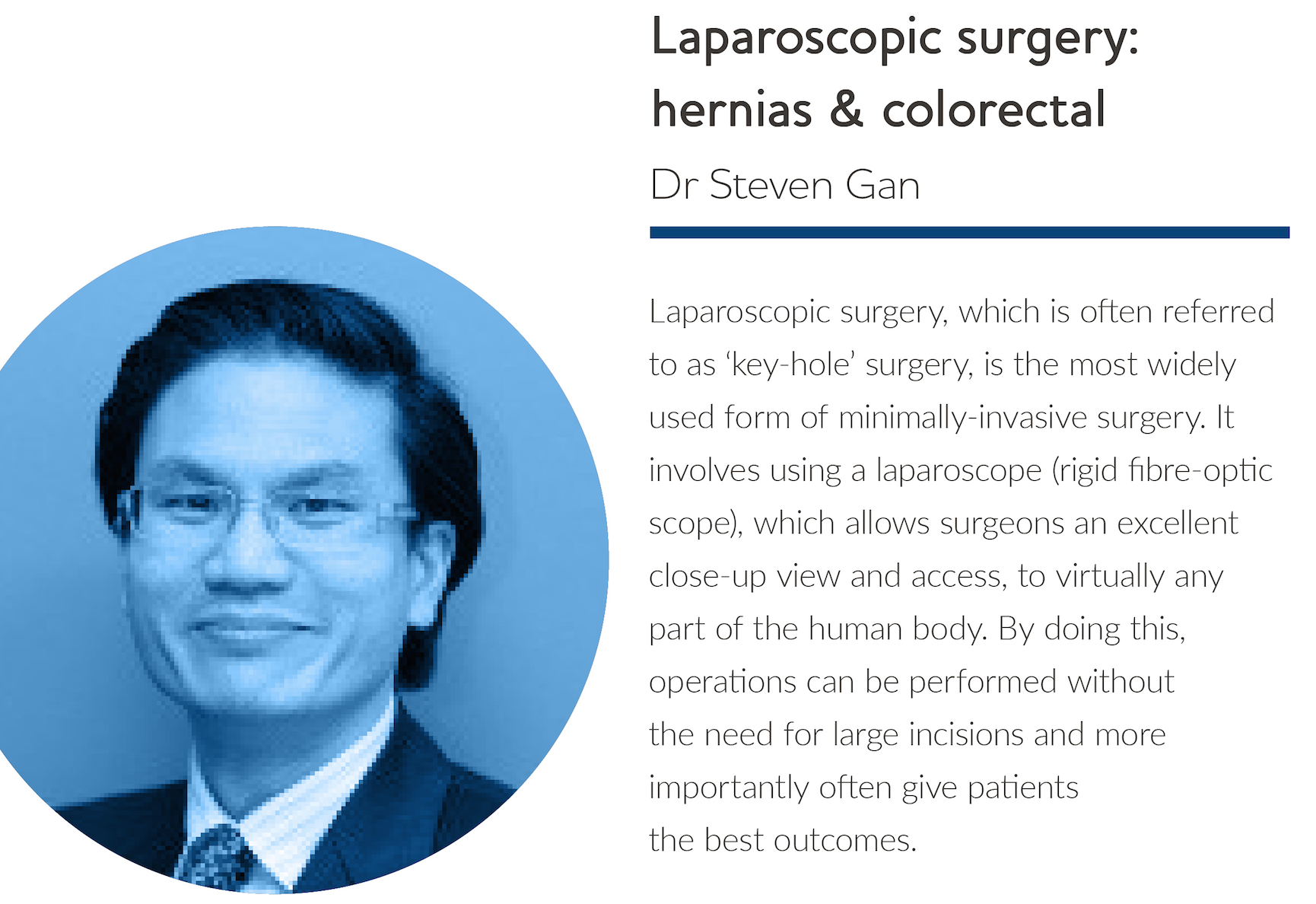Colorectal
Hurstville Private Hospital GP Bulletin
June - July 2019

Hernias are a common condition that affects both men and women. It is a benign condition, but can be very debilitating. Pain is the most common symptom, and patients often complain of a lump as well. In general terms, a hernia develops when a body organ such as fat or intestine, protrudes through a weakness in the tissue containing it; usually muscle. The name preceding the word hernia, describes its location and origin; such as an inguinal hernia which develops in the inguinal region, or an incisional hernia which develops following a previous incision. Hernias do not always need to be repaired surgically, but if they do, surgeons usually do so laparoscopically.
Inguinal hernias are the most commonly repaired type of hernia. Laparoscopic herniorraphy involves making a small incision under the umbilicus and insufflating carbon-dioxide into the tissue plane between the rectus abdominus (abdominal wall muscle) and the peritoneum (thin tissue sac containing internal organs). Once this tissue plane has been established, the laparoscope and two more ports (plastic sleeves) are inserted through the skin, to allow other instruments to be used for the operation. The hernia is then returned to its normal/natural position, and the hernial defect (hole) is repaired with mesh. During the subsequent six-weeks, the body’s own scar tissue will give strength to the mesh repair of the hernia. Laparoscopic surgery has meant that patients can now have the operations performed with three small incisions of less than a centimetre, as compared to a significantly larger incision of the past. This has the benefit of a much quicker recovery, usually day-surgery, and certainly a less painful one; studies have also shown that there is no difference in the recurrence rate between laparascopic and traditional open repair.
The indications for colorectal operations can broadly be divided into benign (non-cancer) and malignant (cancer) causes. However, the types of operations needed for removing part or all of the colon (large intestine/bowel) are often performed by the same technique. The colon is described as comprising five parts from right to left; the caecum, ascending colon, transverse colon, descending colon and sigmoid colon. The last part of the bowel is referred to as the rectum. Depending on which part of the colon needs to be removed, surgeons will perform one of the following operations: right hemicolectomy, extended right hemicolectomy, anterior resection (high, low, ultra-low) or an abdominoperineal resection.
Laparoscopic colectomy involves inserting a port into the abdominal cavity and insufflating carbon dioxide. Once the abdomen is distended, a laparoscope is inserted, and up to four more ports are used for other instruments. Grasping forceps and an instrument which uses heat to cut through tissues, are used to mobilise (free-up) the part of colon intended for resection. Once the colon is adequately mobilised, a small cut in the abdominal wall is made to externalise it, and the pathological segment removed. If the resection is for a malignant cause, it is essential to remove the adjacent lymph nodes. An anastomosis (join) is then carried out.
Some of the greatest benefits of laparoscopic surgery are seen in colorectal operations. Often needing to work in the small, confined space of the pelvis, laparoscopy allows surgeons unparalleled views and access to operate not only more accurately, but also without the need for large incisions. This, as previously mentioned, is far less painful in the post-operative period, and as a flow-on effect, means that patients can move around more freely and comfortably as well as perform their breathing exercises more effectively; a vital part of the recovery process. In the long term, it is also less likely that patients will develop adhesions following laparoscopic surgery, and the risk incisional hernias is also lower as compared to traditional open surgery.
Operations, no matter how they are performed, should be done to the best of a surgeons abilities, and to provide patients with the best possible outcomes. If, however, minimally-invasive laparoscopic surgery is available and can be done without compromising the results, then the benefits speak for themselves.
Dr Steven Gan, MBBS, FRACS
Dr Steven Gan is an expert Colorectal Surgeon who has been practicing for over ten years. He specialises in advanced laparoscopic surgery, particularly hernia and colorectal cancer operations.
Dr Gan combines a busy clinical practice with his special interest in surgical training. As Director of the Surgical Skills Network of Southern Sydney from 2008-2011, he was responsible for the education and training of junior surgeons.
Consulting Locations
- Hurstville
- Miranda
- Kogarah
CONTACT DETAILS
T (02) 8566 1000
Suite 3, Level 2
Hurstville Private Hospital
37 Gloucester Road
Hurstville NSW 2220